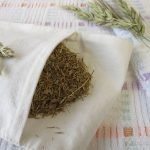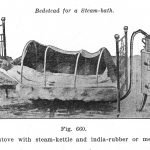Sussanna Czeranko, ND, BBE
The hair is of great importance to every human being. Its care, however, is neglected too much in many cases and in other cases, too much extravagance is shown by applying many expensive hair tonics or hair salves and ointments.
Benedict Lust, 1902, p.258
The druggist or barber picks out a bottle from his closet, and says: “This is the best on the market.” The customer buys it and pays for it, without noticing the bald head of his philanthropic furnisher.
Hermann Imsand, 1903, p.301
It can be said that even the absolutely bald heads may again take hope, on the basis of my discovery [the mucusless diet]; after all tonics have failed, and must fail. The reason is that the cause is not external and therefore cannot be got at externally. Whoever sees his hair falling out, or whoever is already bald, and wishes to regenerate in this direction, may apply to me for advice.
Arnold Ehret, 1912, p.437
Aging comes with numerous undesirable side effects: stiff joints, unforgiving wrinkles, forgetfulness, and a diminishing number of hair strands on top of our heads. Hair loss brings vanity out of hiding like nothing else. When we start to notice that our hair isn’t as thick or luxurious, or perhaps our first gray hair, how quickly the first pang of panic sets in. Lurking in drug stores and supermarkets are dozens of brands of shampoos, conditioners, hair coloring, hair gels, detanglers, hair thickeners, sprays, and curlers. Whole industries have emerged over the last century, built upon promoting beautiful human hair. From the early, alkaline, water-soluble Schwarzkopf power shampoos (popular in Germany) to the world’s first pH-balanced Breck shampoos in the early 1930s, the race has been on to corner hair-care dollars. In the quest for youthful, robust locks, much has been written and much has been spent. The topic of this month’s article is hair and how our early naturopathic doctors helped their patients to keep it healthy and beautiful hair, even when the body has other ideas.
It is fascinating to read the literature from a century ago on what the early Naturopaths thought about hair. We have discovered a lot of science in the interim, but their notions still have enduring merit. If we get past the archaic lexicon of that era, we can arrive at a pretty clear appreciation of their clinical pearls that they have left behind for our generation to savor and use.
Hair Culture
Our hair is a signature of sorts, providing each person with a unique appearance and character, including the option of shifting that image on demand. As no 2 people have the same fingerprints, our hair helps to further embellish our uniqueness. The hair culture established over a century ago helped shape awareness of the importance of personal hygiene and health. At the turn of the last century, Stier was already busily educating his patients about hair. He writes, “Hair grows over almost the whole body. The hairs are formed in little pits, called hair follicles, in the cutis vera and emerge with their excretory ducts from the surface of the skin.” (Stier, 1905, p.51) A short time later, the concept of hair acting as a conduit for internal gases to leave the body was prominent in the literature. Arnold Ehret recognized that “the hair of the human head [was] a very important organ, which aside from protective and warmth regulating purposes, had a highly interesting and useful destination: to conduct away the exhalations, the odor of healthy and sick people, which reveals to experts and acute noses not only individual qualities, but even certain disclosures as regards the inner state of health or sickness of a man.” (Ehret, 1912, p.436) Essentially, Ehret is alluding to the accumulation of waste products in the body, and principally mucus, as the cause of problems with hair loss. Hair loss was synonymous with aging.
Hair, after all, is one of the visible objective signs that we as clinicians have in assessing our patients. If the patient’s hair is greasy, dry, thin, prematurely gray, unkempt, exhibiting patchy baldness or dandruff, etc, we are propelled to pay attention to underlying causes. On the other hand, healthy hair is easy to recognize. We see shiny, sumptuous, thick hair as desirable and healthy. In this regard, Benedict Lust stated, “A heavy growth of hair is the sign of a good strong constitution.” (Lust, 1902, p.258) Indeed, an emphasis on healthy hair was included by the early Naturopaths in their term, “Hair Culture.” Guidelines on how to care for the hair were the foundation and the objective of Hair Culture (Figures 1, 2).
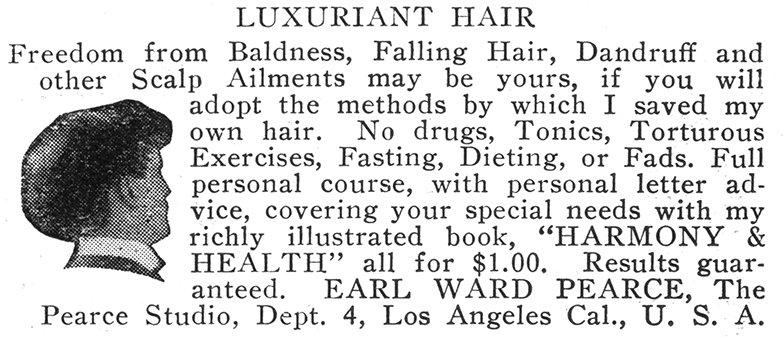
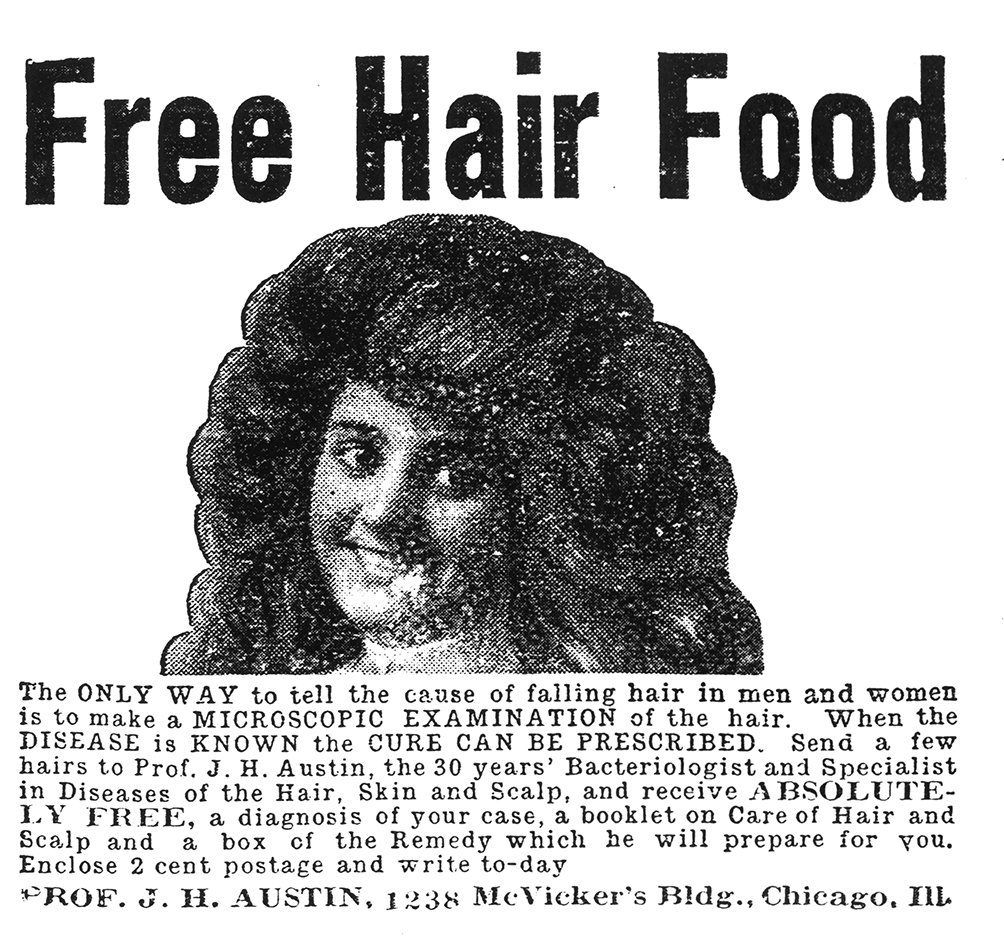
Stier provides suggestions on the care of hair that include the staples of cleanliness and brushing. However, he went further, recommending that the temperature of the water used to wash hair be tepid, though our vocabulary would claim that 68° to 77° F/ 20° to 25° C water is cold. (Stier, 1905, p.51) Drying the hair was done with great care. Stier describes the procedure: “The best plan is to dry the hair gently with a soft towel and then, wrapping a second dry towel round the head, to sit in the sun, in a place free from draughts, till the hair is thoroughly dry.” (Stier, 1905, p.51) Hair dryers were non-existent in the days of our early Naturopaths. How puzzled they would be to witness our habits of hair dryers that blow hot air, making hair dry and brittle.
Hair Loss
The anguish caused by hair loss is not lost on the beauty industry, nor on distribution networks which range from corner drug stores to big-box wholesale operations and online retailers with overnight delivery. These merchandising channels reflect demand from everyone who takes an interest in hair appearance, including products to address hair loss. We generally associate hair loss with old age; however, every age group is affected by the distressing loss of hair. Some of the causes that George Stier attributed to hair loss included “violent emotions, severe and prolonged brain work, especially when attended with anxiety, … severe illness, hereditary predisposition, erroneous treatment, and neglect of the hair.” (Stier, 1905, p.51-52) Lust also made correlations between people with thin hair with nervousness and cold extremities. (Lust, 1902, p.258)
No doubt we are not surprised to learn that the early Naturopaths recognized that sedentary lifestyles and those with desk jobs characterized by excessive mental work needed to take extra care of their hair. Lust cites dysfunctional blood circulation arising from such sedentary mental work. He suggests that these people “attend to the blood circulating evenly all over the body by detracting the blood to the lower extremities by plenty of walking exercise … [and] especially recommend walking barefooted as much as possible.” (Lust, 1902, p.259)
Another recommendation made to encourage the redistribution of blood circulation to aid hair growth was the use of the stimulating head-packs used at night. (Stier, 1905, p.51) The cold compresses were wrung out and then secured on the head with a warm and dry covering such as a woolen hat or toque.
Haircuts
Can having a haircut promote hair growth? This question was posed over a century ago by Dr Gotthilf Thraenhart. He responds, “It is erroneous to think that the hair grows like plants, which thrive stronger if cut.” (Thraenhart, 1911, p.346) Observing a plant when a stem is removed, the plant will form a scar and sap that promotes new stems and buds to spring forth. Having been a gardener, and especially in the Pacific Northwest, the virulence of plants is unquestionably remarkable. Weeding out undesirable plants is the gardener’s woeful preoccupation, especially when the plants return in greater numbers. Hair is not a plant, as Thraenhart explains: “The shaft of the hair is only a dead tube without vessels or nerves and therefore neither bleeding nor pain is caused by cutting it.” (Thraenhart, 1911, p.346) But the observation that many have is that after a haircut, the hair becomes stronger and grows faster. How can this be? Thraenhart suggests, “The cause of this [growth] is solely that the skin of the head becomes lighter, can better evaporate, is more accessible to the air and the water, and is more influenced by washing, drying and brushing.” (Thraenhart, 1911, p.346) While this perspective was popular, it was by no means exclusive. Other naturopathic doctors of the era, understanding the finite nature of hair follicles, encouraged natural hygiene and nutrients to optimize keratin production and hair shaft growth. As always, the early Naturopaths promoted good circulation, including the nourishing of every follicle on a patient’s head whose every follicle had tiny blood vessels stimulating growth. Thus, hair health included the celebrated air baths and sun baths, recognizing the importance of sunshine and fresh air on the skin and the scalp, and on the body’s yearning for good circulation.
In the February, 1921 article, “Cheer up! There is Still Hope for Some of Us,” Lust reports on a German professor who discovered that hydrolyzed keratin increased the production of hair not only on humans, but also sheep. “Professor Zuntz began his experiments on himself, and states that whereas before beginning treatment he grew an average of 5 mg. of hair per day on his head and face, after consuming from 1 to 1.5 mg of hydrolyzed keratin every day for two months, his average production of hair was 9.22 mg.” (Lust, 1921, p.95) In Zuntz’s trials, one man had to abandon the treatment “because he had to shave twice a day!” (Lust, 1921, p.95)
Dry Hair
Dry hair was recognized as a problem. Stier zeroes in on the sebaceous glands in addressing this dry hair condition: “The hair naturally contains a certain quantity of grease secreted by special glands, which prevents it from becoming brittle.” (Stier, 1905, p.51) Today, we have an assortment of shampoos to remedy dry hair, but long before the 101 brands that occupy shelf space in our favorite shampoo store, Kneipp’s Nettle Water and Nettle Oil were the hair products that restored hair to health. Hermann Imsand extols the virtues of the Kneipp’s Nettle hair tonics: “[Kneipp] discovered the right medium… in nettles, as they contain the producing properties for the hair. He extracted the oil as a nourishment for the hair and uses the nettle water as a preserver.” (Imsand, 1903, p.301)
Baldness
Arnold Ehret saw baldness as an acceleration of premature aging. Recognizing that each person’s hair follicles had a unique growth cycle and that each person’s life rhythm and lifestyle choices affected overall health, including hair health, Ehret posited numerous explanations for hair loss. Noting trigger events which upset the patient’s systems, hormonal changes, and numerous skin disorders which could cause scarring alopecia, he reminded his patients about basic health concerns that also contributed to baldness. He writes, “The main cause of baldness lies in the disturbance of digestion and interchange of matter, it can certainly be cured by regulation of these functions.” (Ehret, 1912, p.437) Ehret’s famous mucusless diet was his answer to baldness. He personally experienced baldness and premature graying of hair after a serious illness. “After having been cured from this serious disease by a dietetic treatment, I saw that at the same time the gray hairs disappeared and that my hair grew into perfect profusion.” (Ehret, 1912, p.437)
Ehret’s colleagues commented that hair remedies such as the herbal teas and decoctions could be effective if the hair roots were still alive. Lust gives some suggestions that can help to assess the health of the hair roots. “As a rule, however, these hair remedies are of no more avail as soon as the scalp has acquired a certain glossiness of appearance like porcelain; then it may be assumed [positively], that all hair roots have been eliminated entirely.” (Lust, 1902, p.259) On the other hand, if the surface of the scalp “is still rough and scaly, help is still possible, because this shows positively, that the hair roots are yet alive.” (Lust, 1902, p.259)
Philip Lovell cites what he considered to be the real problem behind baldness:
The disease processes which lead to baldness cannot, in their very nature, start from outside. They must start from within, for that portion of the hair lying inside the skin is the only living part. The part of the hair which protrudes beyond the surface of the skin is bloodless and nerveless, therefore dead.
(Lovell, 1927, p.134)
Lovel contended that the real reason for baldness was “impairment of nutrition, tightened hatbands, too much hat wearing, too little exposure to the sun and elements, and excessive consumption of greasy foods, meats and fats.” (Lovell, 1927, p.134)
Gray Hair
A century ago, gray hair was chiefly associated with old age. Herman Borkenhagen comments, “The turning gray of the hairs is generally considered as a sign of approaching old age. The hairs become usually gray at the age of 50 or 60.” (Borkenhagen, 1910, p.742) Today, such is not the case. Young people can be found with gray hair, and with the advent of hair dyes and coloring agents, gray hair can be kept secret. Borkenhagen attributed gray hair to “sorrow and cares, a continuous headache … strenuous brain work.” (Borkenhagen, 1910, p.742) Borkenhagen does not deny that many people have died with their natural hair color; however, he reasons that people could retain a natural, robust color for their hair if they adopted a “natural mode of life and culture of the body, an important factor in preserving the color of the hair.” (Borkenhagen, 1910, p.742)
Hair Tonics or Snake Oil?
Our infatuation with our hair often leads us to do absurd and fatuous things in the grooming of our hair. A century ago the Naturopaths noted this phenomenon, too, among their patients. A small fortune can be spent in our pursuit for the perfect hairdo. So too, a century ago. Lust notes, “Too much extravagance is shown by applying many expensive hair tonics or hair salves and ointments.” (Lust, 1902, p.258)
Hair tonics have always offered up a promise to erase baldness and make hair beautiful, and this was also the case in the early 20th century too (Figure 3). Lovell ponders these alcohol-based tonics with the following question, “How can you expect a hair tonic, rubbed in on the outside, affecting only the top few layers of cells, to get deep into the hair follicles and do the work it is intended to do?” (Lovell, 1927, p.134)
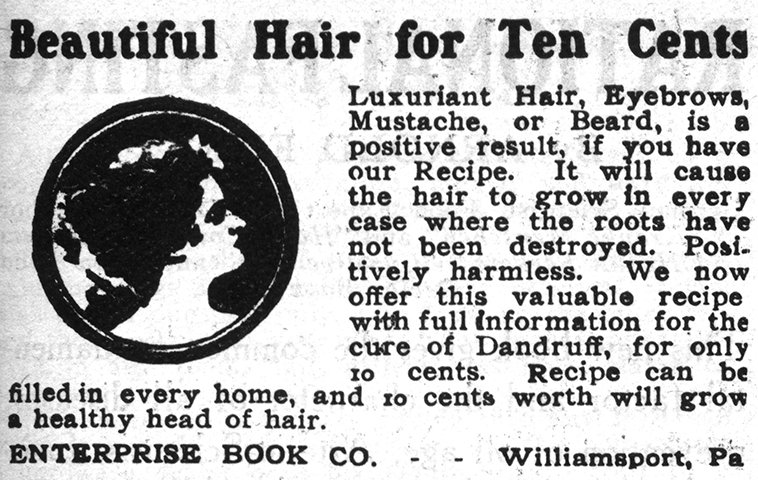
Father Kneipp’s Hair Tonic
One hair formula that did pass the test of time was Kneipp’s hair tonic. Today, in European shops, and health food stores, nettle hair tonics can be found. Lust was a diligent student of Father Sebastian Kneipp, and adopted his nettle hair formulas. In the first formula, dried nettle leaves were boiled in water for several minutes and then a small amount of vinegar was added. (Lust, 1902, p.259) “Another good remedy is prepared by boiling the roots of the nettle in ⅔ water and ⅓ vinegar for some time and after allowing this decoction to stand for some weeks, the solution will be found to be a really excellent hair tonic, if the scalp is washed well with it several times each week.” (Lust, 1902, p.259) For both of these tonics, a key element of the treatment was massaging thoroughly the nettle concoction into the hair and the scalp.
Burdock was another herb that “acts beneficially on the growth of the hair.” (Lust, 1902, p.259) Lust recounts the instructions for a hair tonic using burdock root and nettle leaves:
The root of the common burdock boiled in water for from five to ten minutes, is very beneficial for the growth of the hair. Results are even better if burdock roots and blind [sic] nettle leaves, in equal quantities, are boiled in two parts of water and one part of vinegar. Let this decoction settle for some days; then strain through a cloth sieve, and add some Cologne. Rub the roots of the hair well several times a week, but in order not to make the skin of the scalp over-sensitive, rub the scalp once a week with some good hair oil. For baldness, in which case the roots of the hair are dead, this recipe will be of no use.”
(Lust, 1918, p.940)
Lust adds another herb to the mix of hair promoters: “An extract made from sallow or Salix caprea used externally, promotes the growth of the hair.” (Lust, 1920, p.406)
- G. Young published a series of articles on herbal remedies in Lust’s publications in 1915 to 1917. His articles were detailed, articulate, and brought a rigor to the topic of herbal medicine. He used a strong tea made by boiling the roots and tops of yarrow to treat dandruff. He wrote that yarrow “will really stop the falling of the hair and renders it soft and glossy. It is one of the ingredients in my herbal hair tonic.” (Young, 1915, p.776) Another herb that Young used in his hair tonic was sage. He states, “I employ this valuable herb in the manufacture of several of my medicines. It is the ingredient I most depend upon in my hair tonic.” (Young, 1916, p.51) He adds, “A strong infusion of [sage] will be found to be a very good wash for those who have diseased scalps and are suffering the loss of hair.” (Young, 1916, p.51)
A Long History
Certainly the early naturopaths had a handle on healthy hair. So too did my grandmother, who lived to 90. She had a thick mantle of hair down to her waist for most of her life. She had a practice of washing her hair once a week in cold water. Lust would have approved because he also recommended that cold water be the only water used for cleaning the hair. He says, “The hair should also be washed at short intervals, but in cold water only – and never and this is important – with any of those advertised perfumed soaps.” (Lust, 1902, p.258)
Whether they were advocating diets rich in iron or vitamin B, or promoting a healthy lifestyle of exercise, open air, and clean water, healthy hair goals were very much part of the timeless repertoire of our remarkable forebears.
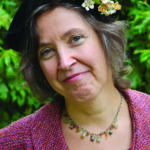 Sussanna Czeranko ND, BBE, incorporates “nature-cure” approaches to primary care by including balneotherapy, breathing therapy, and nutrition into her naturopathic practice. Dr Czeranko is a faculty member working as the Rare Books curator at NCNM and is currently compiling a 12-volume series based upon Benedict Lust’s journals, published early in the last century. Her published books include: Origins of Naturopathic Medicine; Philosophy of Naturopathic Medicine; Dietetics of Naturopathic Medicine; Principles of Naturopathic Medicine; Vaccination and Naturopathic Medicine; and Physical Culture in Naturopathic Medicine. Dr Czeranko is the founder of the Breathing Academy, a training institute for naturopaths to incorporate a scientific model of breathing therapy called Buteyko into their practice. She is also a founding board member of the International Congress of Naturopathic Medicine and a member of the International Society of Medical Hydrology.
Sussanna Czeranko ND, BBE, incorporates “nature-cure” approaches to primary care by including balneotherapy, breathing therapy, and nutrition into her naturopathic practice. Dr Czeranko is a faculty member working as the Rare Books curator at NCNM and is currently compiling a 12-volume series based upon Benedict Lust’s journals, published early in the last century. Her published books include: Origins of Naturopathic Medicine; Philosophy of Naturopathic Medicine; Dietetics of Naturopathic Medicine; Principles of Naturopathic Medicine; Vaccination and Naturopathic Medicine; and Physical Culture in Naturopathic Medicine. Dr Czeranko is the founder of the Breathing Academy, a training institute for naturopaths to incorporate a scientific model of breathing therapy called Buteyko into their practice. She is also a founding board member of the International Congress of Naturopathic Medicine and a member of the International Society of Medical Hydrology.
References
- Borkenhagen, H. (1910). Gray hair. The Naturopath and Herald of Health, XV (12), 742.
- Ehret, A. (1912). Sick people. The Naturopath and Herald of Health, XVII (7), 434-438.
- Imsand, H. (1903). Falling out of the hair and the nettle hair water and nettle hair oil of Father Kneipp. The Naturopath and Herald of Health, IV (10), 301.
- Lovell, P. M. (1927). Hair tonics. Nature’s Path, III (3), 134.
- Lust, B. (1902). Care of the hair. The Naturopath and Herald of Health, III (6), 258-259.
- Lust, B. (1918). Selected herbs. Herald of Health and Naturopath, XXIII (12), 940.
- Lust, B. (1920). Selected herbs. Herald of Health and Naturopath, XXV (8), 406-408.
- Lust, B. (1921). Selected herbs. Herald of Health and Naturopath, XXVI (2), 95.
- Stier, G. (1905). Hair culture. The Naturopath and Herald of Health, VI (2), 51-53.
- Thraenhart, G. (1911). Does a short hair cut make the hair grow? The Naturopath and Herald of Health, XVI (6), 346.
- Young, M. G. (1915). Yarrow. The Naturopath and Herald of Health, XX (12), 775-776.
- Young, M. G. (1916). Sage. Herald of Health and Naturopath, XXI (1), 50-51.


